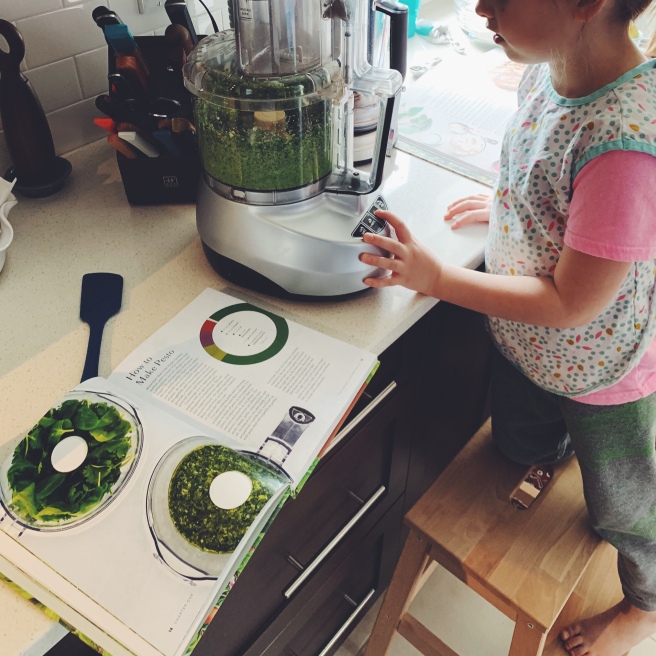
My most distinct food memory of pesto begins in my early twenties when I travelled off to attend school in Eastern Ontario. By then, I knew basic recipes and cooking techniques I learned from my mom and, thanks to the dedicated teachings of Mrs. H, my home economics teacher, but anything beyond the basics was out of my skill set. As I met new people, I found my culinary experiences broadening, and, when I met Olivia, I knew I had found a kindred spirit. We would often talk about recipes and ingredients and, since she cooked so much and, grew up in Europe and lived in Japan, I really appreciated her vast culinary knowledge and expertise. It was Olivia who taught me how to make pesto and, at the time, I couldn’t believe how easy it was to make at home with a few ingredients.

My experience with pesto had been at restaurants and with the pre-made variety found at grocery stores. Olivia showed me that combining basil, parmesan cheese, pine nuts, and olive oil in my mini chopper I could achieve a delicious pesto! It was a turning point for me because I realized that many of the things I enjoyed eating at restaurants — such as pesto — I could probably make at home. Her recipe has stuck with me over the past 20 years because of its versatility — pesto can be enjoyed as part of so many other dishes. It helps to build flavour and to provide a base.

At the beginning of 2020, I treated myself to a few new cookbooks — Pesto: The Modern Mother Sauce by Leslie Lennox (owner of Hope’s Garden) was one of the titles I bought. As a fan of pesto, I’m always looking to expand my pesto repertoire and, Lennox’s cookbook seemed like just the book to help me achieve this. Thinking along the lines of the original “mother sauces” from French gastronomy (bechamel, espagnole, veloute, hollandaise, and tomat), in the introduction, Lennox looks at how others, like Samin Nosrat, expand on and have begun to redefine what a mother sauce looks like for modern cooks. What is crucial for Lennox’s purposes is that as Nosrat defines the “modern mother sauces” as: yogurt, pepper (hot sauce/chili sauce), herb, tahini, and pesto; Lennox presents the purpose of her book: “Unlike those early mother sauces, this one can come from your backyard, reduce waste, and deliver healthy, nutritious vegetables into your diet in delicious and surprising ways.”(13)

The cookbook is organized into two parts — basics of pesto making and recipes that use pesto. I really appreciate that while Lennox offers a guide for home cooks to follow, she also encourages experimentation too. There is a variety to the recipes which use pesto: from eggs and toast to appetizers, pizza, pasta (and more!). While the pesto itself is vegetarian (or vegan depending on what ingredients you use), the recipes using pesto offer a range from vegetarian options to ones that use meat, fish, and poultry. Leslie’s husband, Dave, also gives detailed and invaluable information about growing your own basil at home. There’s a glossary of important culinary terms as well as “worksheets” for jotting down personal combinations you might create. What Pesto: The Modern Mother Sauce offers is a compendium on pesto.

In some ways, this has been the perfect book for home cooking during the pandemic. I find I rely on her basic “how to” ratios for making pesto when I want to make the most of the ingredients I’ve got on hand — no cheese or nuts? No problem! Lennox advocates for the home cook to be thoughtful and resourceful, which allows them to create a pesto to suit their needs and tastes. Lennox outlines the 6 basic components of pesto (3 of which — the nuts, cheese, and garlic — are optional) and she provides lists of ingredients for the plant, cheese/cheese substitute, oil, nuts/seeds, and acid/seasoning components. With the information she provides, it seems that the combinations for making pesto are limitless. If this sounds overwhelming, Lennox also offers “tried and true” combinations as well. Her recipes for Kale Pesto as well as for Spinach Pesto are my go-to because the recipes help to stretch out the spinach or kale over a few meals. Kale can often have a tougher texture for my young daughter, so I find that by incorporating the kale into a delicious pesto helps to make it more palatable for her.
Each week I make a big jar of pesto that I use throughout the week in sandwiches, pasta, dressings, as well as on pizza. A spoonful of pesto (or two) added to a soup or sauce also gives whatever you’re making more flavour. And, while Lennox offers a wealth of recipes, I’ve found that I prefer to add the pesto to whatever I’m already making. For example, I found that adding a generous dollop of pesto to roast potatoes adds flavour and nutrients than just serving them with sour cream. Also, I take the opportunity to make my own pesto now, rather than using store bought as is called for in other cookbooks. I find that the recipe for Classic Basil Pesto from the Lennox’s book tastes great with my daughter’s favourite pizza scroll recipe. And who could resist a luscious swipe of pesto on a hunk of fresh sourdough or as a base on avocado toast?

Pesto: The Modern Mother Sauce is such an excellent kitchen resource! Sharing the task of making pesto with my young daughter is a great way of showing her how to combine different flavours and ingredients, as well as teaching her new kitchen skills. I appreciate how Lennox encourages home cooks to use what is in season/local when making and enjoying pesto. My own pesto repertoire has been expanded far past the basil version I learned from my friend those many years ago and, I find I’m continually inspired by Lennox’s enthusiasm for how versatile and delicious pesto is.

I used my own personal copy to happily write this review.




One thought on “Book Club Tuesday: Pesto”